|
|
|
Sort Order |
|
|
|
Items / Page
|
|
|
|
|
|
|
| Srl | Item |
| 1 |
ID:
147457
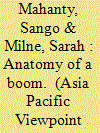

|
|
|
|
|
| Summary/Abstract |
This paper examines how a boom in industrial cassava served as a ‘gateway’ to intensify capitalist relations in Cambodia's north eastern borderland. Situated on Cambodia's border with Vietnam, Mondulkiri province has experienced a rapid increase in cassava production and trade since 2006, with transformative consequences for the region's forests and farmers. Using field data from 2012 to 2014, we explore how the boom ignited and intensified over time, through a conjuncture of conditions. Alongside strong market demand for cassava, these included resource abundance (soil fertility, timber, land, labour), connectivity to markets and cross border networks, and facilitative governance conditions. Over time, the boom strengthened capitalist relations, particularly through farmer debt and the revalorisation and accumulation of land. However, unlike booms of tree crops elsewhere, we argue that it is the very impermanence of cassava that is formative here, because the crop's short-term nature and low overheads facilitate practices like land laundering and land mortgaging. Like the ‘gateway drugs’ that were believed to place users on a path to addiction and risk, this paper shows that gateway crops such as cassava may similarly place farmers on a trajectory of more intense competition and reduced choice in their engagements with capitalist modes of production.
|
|
|
|
|
|
|
|
|
|
|
|
|
|
|
|
| 2 |
ID:
147464


|
|
|
|
|
| Summary/Abstract |
This paper analyses how the economic actions of water distribution and exchange are embedded in the culture of indigenous communities in the Cordillera highlands of Northern Luzon, Philippines. Such actions are fundamental to water access and provisioning. Data was derived from a series of focus group discussions conducted with various water users, including households, farmers, enterprises and local government officials, and from upstream, midstream and downstream communities along the Balili River, a critical watershed in the Cordillera highlands. The study area exhibits a mix of livelihood systems and both formal and traditional institutions of decision-making. Recognising that water is both an economic and social good, this paper draws inspiration from Polanyi's concept of embeddedness. Cases of three communities suggest that water distribution and exchange are embedded in the community's socio-cultural spaces, but the extent of embeddedness declines as communities transform from subsistence to market-based economies. Embeddedness also determines value and availability of water. The paper contributes to the discourse on the cultural economy of water and provides direction on new modes of decision-making on river management that promise more inclusive, equitable and ecologically sustainable outcomes.
|
|
|
|
|
|
|
|
|
|
|
|
|
|
|
|
| 3 |
ID:
147461


|
|
|
|
|
| Summary/Abstract |
This paper illustrates conflicting priorities in Japan's aid policy to Cambodia and how those policies appear in the implementation of the aid. Japan's aid is driven by a strategic policy to integrate Cambodia into the regional economy while the same aid focuses on assisting small-scale farmers in that country. On the Cambodian side, the government has employed a market-oriented approach of development in the context of local patron/client mode of governance, in which, the agricultural policy has also become oriented towards large-scale investment and export. By looking at the case of Japan's technical cooperation in Cambodia's rice sector, this paper examines how the conflicts within Japan's aid policy are internalised in the Cambodian context and appear as conflicts between Japanese and Cambodian approaches to agricultural development.
|
|
|
|
|
|
|
|
|
|
|
|
|
|
|
|
| 4 |
ID:
147454
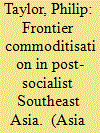

|
|
|
|
|
| Summary/Abstract |
The articles in this special issue examine processes of commoditisation in the frontiers of post-socialist Southeast Asia. Focusing on livelihood transformations in the borderlands of Laos, Cambodia, Vietnam and Thailand, the case studies reveal how relatively understudied actors, networks, flows and conjunctures initiate and shape commodity booms. Exploring how borderlanders engage, resist, cope with and survive commoditisation, the articles chart associated changes in values and in people's relations with each-other and their environment. This introductory article contextualises this new research and discusses the implications of the findings.
|
|
|
|
|
|
|
|
|
|
|
|
|
|
|
|
| 5 |
ID:
147460
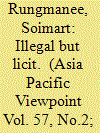

|
|
|
|
|
| Summary/Abstract |
Based on research in a border village in Northeast Thailand and two villages in Laos, this paper discusses how formal regulations on cross-border migration are negotiated, such that the practice becomes socially acceptable amongst receiving communities. This paper focuses on the border-crossing experiences of Lao migrants to argue that regulations governing the Thai–Lao borders have been circumvented in response to labour demands in the Thai borderlands and mutual interest between local state officials and borderlanders. It is illegal for undocumented migrants to cross the Mekong to work in the farms along the Northeast Thai–Lao borderlands, but the practice has become socially acceptable. This licit1 status helps Lao migrants to navigate local state authorities, who are also involved in local social relations.The importance of local social relations is emphasised by differences in cross border-migration between jobs in agriculture and jobs in service industries. In urban settings, migrants do not participate in local social relations to the same extent. Consequently, they are viewed as illicit2, as well as illegal. While acknowledging the ongoing legal constraints on migrants and their movements, this paper seeks to provide an understanding of how state authority in the border regions is mediated by enduring social relations that create a legitimate space for informal and mutually beneficial actions.
|
|
|
|
|
|
|
|
|
|
|
|
|
|
|
|
| 6 |
ID:
147456
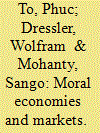

|
|
|
|
|
| Summary/Abstract |
Vietnam's uplands have been increasingly integrated into commodity production for global markets. This paper focuses on the role of the cassava trader in connecting upland villagers as cassava producers to an emerging global cassava market. In Vietnam's Central Highlands, ethnic minority villagers engaging in a mixed economy of subsistence and cash crop production still practice communal resource use and reciprocal labour arrangements – customs associated with the (contested) notion of ‘moral economy’. In this context, traders have strategically traversed the insider–outsider divide, enlisting trust and reciprocity to extend the patron–client relationship between traders and villagers. In the absence of state support for upland communities, these traders have embedded themselves within village social relations through the provision of multiple goods and services, including loans. Villagers turn to these traders during times of hardship through degrees of mutual dependence in often unequal trade relations. The ‘benevolence’ of the traders, however, is an explicit strategy to legitimise their economic benefits. The relationship is deepened because traders fill a vacuum in state services by providing technical support to farmers cultivating cassava. Beyond benefiting themselves, in their status as community ‘insiders’, traders promote market penetration into the uplands with associated social and environmental implications.
|
|
|
|
|
|
|
|
|
|
|
|
|
|
|
|
| 7 |
ID:
147463


|
|
|
|
|
| Summary/Abstract |
This paper analyses how rural households engage in different segments of non-farm wage labour markets using panel data from three Vietnamese provinces that also include perceived reasons for obtaining employment. We show that it is important to appreciate the heterogeneous nature of rural non-farm wage employment from a livelihood perspective. Different jobs vary in terms of seasonality, earning potential, social insurances, location and entrance requirements. Most notably, public service jobs are most favourable from a livelihood perspective. Regarding factors influencing participation, education has a positive effect on engagement in public and private service jobs, a negative effect on participation in construction jobs and no significant effect on employment in industry jobs. Further, family contacts are crucial in the process of finding non-farm employment in all sectors. The disaggregated approach allows a better conceptualisation and can lead to better targeted policy recommendations.
|
|
|
|
|
|
|
|
|
|
|
|
|
|
|
|
| 8 |
ID:
147459
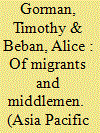

|
|
|
|
|
| Summary/Abstract |
In a possible sign of a new trend in Southeast Asia, economic pressures are driving smallholder shrimp farmers from Vietnam's Mekong Delta across the Cambodian border in search of new land. Building from ethnographic research with Vietnamese shrimp farmers in Kampot province, Cambodia, this paper explores the structures, mechanisms and relations that facilitate and impede the ability of Vietnamese migrants to gain and maintain access to land in Cambodia. The Vietnamese migrants in our study bring capital and farming skills, but their ambiguous legal status and their lack of social networks and experience with the terms of access in Cambodia render them vulnerable to exclusion and dependent on a local broker to mediate their interactions with landowners and authorities. We recount the migrants' attempts to overcome the uncertainty of their mediated access by bypassing the broker and cultivating direct social ties with Khmer villagers, border authorities and the landowners themselves. This study generates new insights into the dynamics of cross-border livelihoods in mainland Southeast Asia and more broadly illuminates the central importance of migrant–broker relationships and migrant agency in seeking to overcome dependency on brokers by forging new social relations in border areas.
|
|
|
|
|
|
|
|
|
|
|
|
|
|
|
|
| 9 |
ID:
147458


|
|
|
|
|
| Summary/Abstract |
One of the unexpected outcomes of increased regional integration in southern Laos has been a boom in household production and roadside sale of wood charcoal. This paper develops an ethnographically informed analysis of charcoal as a socially embedded market, providing insights into the sociopolitical relations of access, legal and extra-legal regulations, and the distribution of rents that characterise this trade. Contrary to some assumptions about charcoal as a necessarily exploitative commodity, this paper points to some of the advantageous income smoothing opportunities that charcoal presents for many rural Lao households and detail the complex ways in which charcoal production can relate to forest sustainability and degradation. The paper elaborates a perspective of entrepreneurial Lao charcoal communities, energetically utilising locally available natural resources, for direct cash income. Charcoal production networks also connect everyday household livelihoods in Laos to large-scale extractive industry, in ways that have been arguably underemphasised previously. At the same time, the charcoal trade highlights the structural limits to notions of smallholder agency and local participation in commodified market relations, within broader political-economic contexts decidedly shaped through uneven development, and accumulation through dispossession.
|
|
|
|
|
|
|
|
|
|
|
|
|
|
|
|
| 10 |
ID:
147462
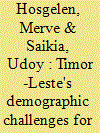

|
|
|
|
|
| Summary/Abstract |
Timor-Leste's nation-building process faces significant demographic challenges because of its current and prospective population dynamics. Based on the 2010 census data this paper projects the demographic structure of Timor-Leste by 2030 and discusses the impact of the same on peace, development and environmental sustainability. This paper projects that Timor-Leste's population will increase from 1.06 million in 2010 to 1.82 million in 2030, and because of a slow decline in total fertility rates, its population characteristics will remain that of a very youthful country with an extraordinarily high dependency ratio. Timor-Leste will have extremely high proportion of excess labour, high concentration of uneducated and jobless youth in small urban areas and an ever-increasing demand on natural resources in the next two decades. In the context of poor performing domestic economy, very low formal sector employment and weak environmental governance, these challenges may well contribute to social conflict which is evident in the nation's recent past. This paper is an attempt to reflect upon the implications of Timor-Leste's population dynamics by 2030 on urbanisation, economy (labour market) and the environment which tend to have a strong relationship with social stability.
|
|
|
|
|
|
|
|
|
|
|
|
|
|
|
|
| 11 |
ID:
147455


|
|
|
|
|
| Summary/Abstract |
In colonial Southeast Asia, the process of enclosure aimed to integrate communities living in the borderlands, along with their lands and resources, into the state project. In 1891, the newly established French colonial administration in Tonkin (northern Vietnam) decided the upland region bordering China should be physically and administratively enclosed to achieve these aims. The governor general ordered the French military to administer these borderlands and to complete two surveys of local ‘tribes’ in 1897–1898 and 1903–1904 to make upland populations and their livelihoods more legible and, the administration hoped, more controllable. By examining details of these surveys, we not only obtain proof of this enclosure project but we also gain rare insight into and a snapshot of upland border livelihoods at the turn of the 20th century. The surveys reveal details regarding local cross-border trade strategies, marketplace manoeuvres, the means by which the colonial government enforced a common currency and, despite such attempts, the enduring nature of barter. We probe how local populations reacted to the state's processes of legibility, and in particular, how upland residents adapted their trade livelihoods to the new realities of being included within the colonial state and, progressively, within the national economy.
|
|
|
|
|
|
|
|
|
|
|
|
|
|
|
|
|
|
|
|
|